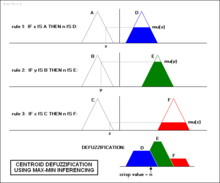Defuzzification
This article needs additional citations for verification. (March 2008) |


Defuzzification is the process of producing a quantifiable result in
The simplest but least useful defuzzification method is to choose the set with the highest membership, in this case, "Increase Pressure" since it has a 72% membership, and ignore the others, and convert this 72% to some number. The problem with this approach is that it loses information. The rules that called for decreasing or maintaining pressure might as well have not been there in this case.
A common and useful defuzzification technique is center of gravity. First, the results of the rules must be added together in some way. The most typical fuzzy set membership function has the graph of a
Methods
There are many different methods of defuzzification available, including the following:[1]
- AI (adaptive integration)[2]
- BADD (basic defuzzification distributions)
- BOA (bisector of area)
- CDD (constraint decision defuzzification)
- COA (center of area)
- COG (center of gravity)
- ECOA (extended center of area)
- EQM (extended quality method)
- FCD (fuzzy clustering defuzzification)
- FM (fuzzy mean)
- FOM (first of maximum)
- GLSD (generalized level set defuzzification)
- ICOG (indexed center of gravity)
- IV (influence value)[3]
- LOM (last of maximum)
- MeOM (mean of maxima)
- MOM (middle of maximum)
- QM (quality method)
- RCOM (random choice of maximum)
- SLIDE (semi-linear defuzzification)
- WFM (weighted fuzzy mean)
The maxima methods are good candidates for fuzzy reasoning systems. The distribution methods and the area methods exhibit the property of continuity that makes them suitable for fuzzy controllers.[1]
Notes
- ^ .
- S2CID 61998554.
- )
See also
- Fuzzy logic
- Fuzzy set
- Fuzzy control
